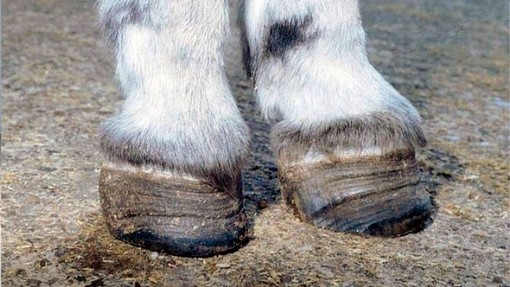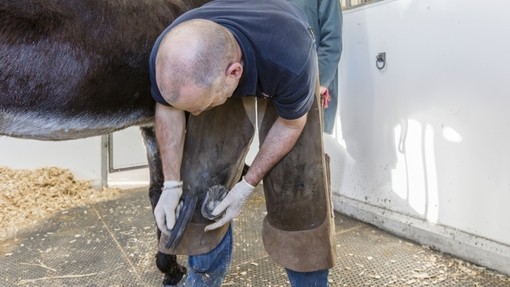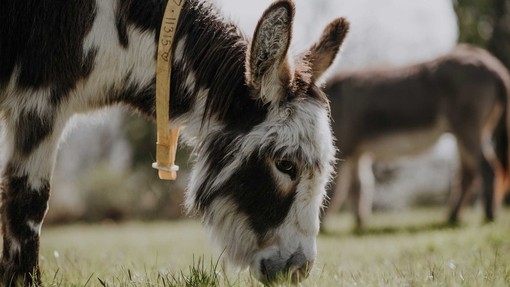The structure of a donkey's foot
There are a number of differences between horse and donkey feet.
- Donkeys’ feet are more upright (between 5° and 10° more) than horses’ feet.
- The donkey foot is “boxier” than the horse foot (the horse’s foot is more conical).
- The sole is more U-shaped (the sole of a horse’s foot is more round).
- Donkeys’ feet appear to grow more from the heel than from the other parts of the foot.
- The donkey grows nearly as much sole as hoof wall and this needs paring by the farrier (in horses the sole growth tends to flake off).
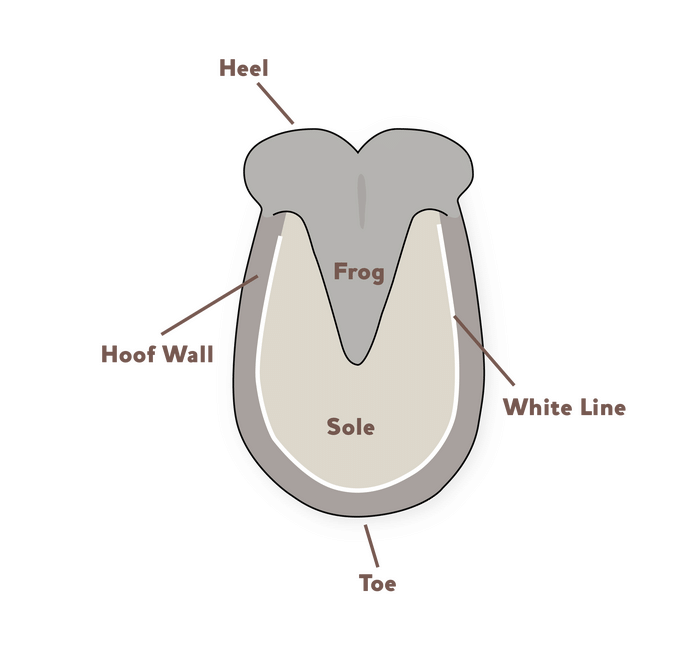
The illustration below is a simplified, diagrammatic section through the donkey’s foot, indicating some of the important structures. P3 is also known as the “pedal bone”, ‘coffin bone’ or the “third phalanx” and it is this bone that can be displaced in severe laminitis. More of the second phalanx, P2, lies inside the hoof capsule than is the case in the horse’s foot.
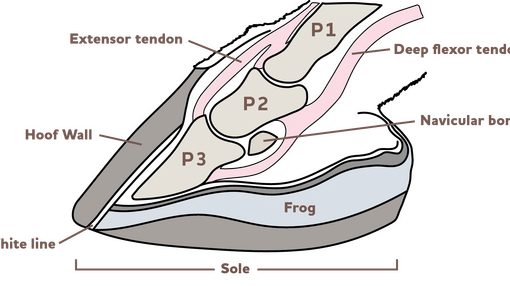
Routine Foot Care
Because of the damp, British climate, it is not possible to keep donkey’s feet dry. However, the aim should be to keep donkeys on dry and clean bedding when housed. When kept outdoors, muddy conditions should be avoided. It is useful to have a dry exercise area, which is very well drained.
All donkeys should have their feet picked out daily using a hoof pick. Be careful to keep the donkeys foot low and do not lift a donkey’s foot too high, this make it more comfortable for the donkey and mean that they are less likely to kick. Especially in older animals with arthritis, it can be painful to lift and twist the leg. If necessary, bend your knees so that you and the donkey are comfortable.
Your farrier should visit every six to ten weeks. It is important to establish a good relationship with the farrier and a good start is to ensure the donkey is tied up in a well-lit area with freshly picked out feet and excess mud washed off the limbs. You are the client and if you are not happy with the standard of work you should seek the services of another farrier.
After trimming, the foot should be left with a concave sole, with the wall bearing the weight. Ideally, the point of the frog or mid-point of the sole should end up around 6 mm ( ¼ in) above the walls, so that the there is no pressure on the sole when the foot is on the ground. However, if the farrier had to do any corrective work, for example for seedy toe, the foot shape may be different at the end of the farrier’s visit.
Trimming donkey hooves
Most donkeys will require a foot trim every 6-10 weeks, but care should be taken with older donkeys who might struggle to lift their limbs. You should aim to keep limbs as low as possible during trimming.
If a donkey’s foot becomes overgrown you should obtain a radiograph prior to trimming to check for any changes to the bone within the hoof. A vet should also be consulted for pain relief.
Donkey hoof problems
Due to our wetter climate in the UK, donkeys are more susceptible to foot diseases, yet most are entirely preventable.
Seedy Toe
When a donkey gets seedy toe, otherwise known as white line disease, the white line area becomes weak and crumbly. Seedy toe lesions are rarely painful unless there is extensive hoof instability, but the widened white line may allow the entry of foreign objects and organisms. Often little stones and dirt can get stuck in the space under the horny part of the hoof, causing the donkey pain or an infection.
Seedy toe is treated by cutting out the affected part of the hoof wall. All dead and discoloured material should be removed to allow the new healthy horn to grow down. Exposure is necessary to minimise the chance of infection. In severe cases, your farrier should work with a vet to make sure that the work does not cause any instability to the hoof.
Once treated, the donkey must also be kept on clean, dry ground until fully recovered.
Thrush
Thrush is an infection of the underneath of the foot, particularly affecting the frog. It has a distinctive, unpleasant smell. It is often associated with keeping the donkey in wet conditions.
Thrush is prevented by keeping the feet clean and dry as much as possible.
Laminitis
Laminitis in donkeys is a veterinary emergency. It is a very painful disease often with irreversible consequences. There are several causes of laminitis: too much rich food, infection or pregnancy. The consequence is a destruction of the support mechanism of the toe bone within the hoof, such that the toe bone can rotate or move downwards.
If your donkey is unwilling to walk, lying down more than usual and has easily felt pulses in the blood vessels around the fetlock, you should contact your vet immediately as this could be a sign of laminitis. Do not make the donkey walk but place in a well-bedded stable, with easy access to food and water until the vet arrives.
The laminitic foot may require more frequent trimming and radiographs for monitoring. During treatment, frog supports or heart bar shoes are not appropriate as they could exacerbate the issue. Instead you should pad the entire sole using thick cotton wool and bandages.
In some laminitic donkeys the sole may be too thin to trim. If radiographs are not available then use your thumb to pressure test and check for yielding of the sole. You should stop trimming once this point is reached. In these cases, it may also be appropriate to apply rim shoes for support.
Foot abscess
Usually the result of a wound that penetrates the sole or white line. An abscess can develop in the foot when the wound is infected and pus builds up. Such wounds can be a cause of Tetanus so ensure that the donkey is protected by vaccination or ask your vet how to protect the donkey.
If you suspect an abscess, you should seek veterinary advice. The vet may recommend a poultice, to help draw the infection out of the foot and/or cut away the abscess with a hoof knife to help the infection to drain out.
An abscess in the foot is intensely painful and requires urgent veterinary attention.
Foot dressings and feed supplements
It is not normally necessary to use hoof oil or any food supplements if the donkey is kept on a good, balanced diet. However, do be guided by your vet as some foot conditions may benefit from vitamin/mineral supplementation.

